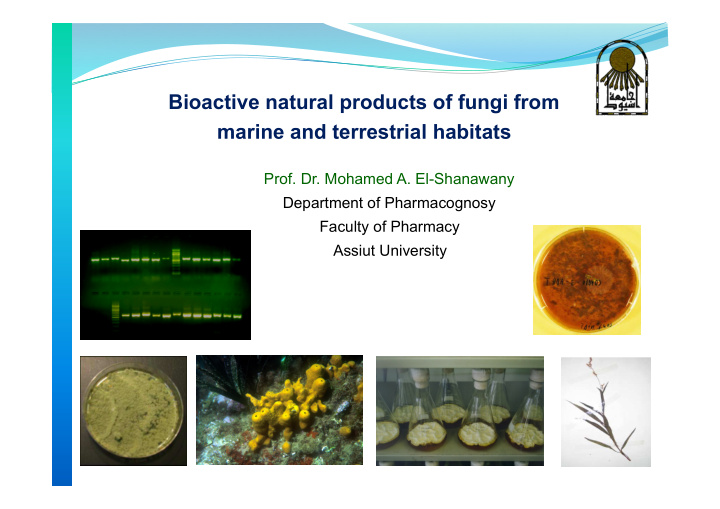



Bioactive natural products of fungi from marine and terrestrial habitats Prof. Dr. Mohamed A. El-Shanawany Department of Pharmacognosy Faculty of Pharmacy Assiut University
WHY MICROORGANISMS ?
Over 120 of the most important medicines (Penicillins, Cyclosporin, Adriamycine,... etc.) are obtained from terrestrial microorganisms. Expected enormous biodiversity of microorganisms. Constitute the ultimate ‘Undiscovered’ frontier for the search of marine natural products. Supplying sufficient materials.
Endophytic fungi inhabit such abiotope. In the course of the last 12 years, about 6500 endophytic fungi were isolated from herbaceous plants and trees, screened for their biological activities, their metabolites and have isolated and determined the structures of the biologically active compounds
The isolated metabolites originated from different biosynthetic pathways: isoprenoid, polyketide, amino acid derivatives, and belonged to diverse structural groups: terpenoids, steroids, xanthones, quinones, phenols, isocumarines, benzopyranones …..etc,
The potential role of the endophyte and its biologically active metabolites in its association with its host has been studied . The fungal endophytes possess the exoenzymes necessary to colonize their hosts.
The fungal endophyte – plant host interaction is characterized by a finely tuned equilibrium between fungal virulence and plant defense. If this balance is disturbed by either a decrease in plant defense or an increase in fungal virulence, disease develops. Many groups of fungi in different biotopes are waiting to be exploited.
Since natural products are adapted to a specific function in nature, the search for novel secondary metabolites should concentrate on organisms that inhabit novel biotopes.
This address some important questions: -Which evolutionary pressures led to gene clustering?, -Why closely related species produce different profiles of secondary metabolites?, -whether fungal genomics will accelerate the discovery of new secondary metabolites of potential biological activity ?
Secondary metabolites from fungi
Microorganisms as a source for natural products
Secondary metabolites from marine-derived fungi Cephalosporin C Acremonium chrysogenum Sorbicillactone A first natural product of a Penicillium chrysogenum marine-derived fungus (1946) ¡ from sponges belonging to the genus Ircinia (2003) ¡
Isolation of microorganisms from marine sponges control #1 cut with a (surrounding sterile blade sea water) control #2 transfer a piece (sponge of the inner part surface) of the sponge onto an agar plate streak over the plate primary isolates pick single colonies; ”dilute” the colony pure culture (mixed cultures) inoculate new agar plates
Fermentation of fungal strains static culture in Erlenmeyer flasks liquid culture in fermenter (5 L scale) solid-state fermentation (rice-based medium)
Flutimide isolated from Delitschia confertaspora Halovir A R 1 = OH, R 2 = CHMe 2 , n=12 Halovir B R 1 = OH, R 2 = Me, n=12 Halovir C R 1 = H, R 2 = CHMe 2 , n=12 Halovir D R 1 = OH, R 2 = CHMe 2 , n=10 Halovir E R 1 = H, R 2 = CHMe 2 , n=10 Fungal metabolites with antiviral activity isolated from Scytalidium sp.
Secondary metabolites from endophytic fungi Paclitaxel (Taxol) originally isolated from the Pacific yew tree, Taxus brevifolia , but later also reported from endophytic fungi, including Taxomyces andreanae and Pestalotiopsis microspora (1993) ¡
Cytotoxic metabolites from endophytic fungi Alternaria sp. from the Egyptian plant Polygonum senegalense cytotoxic activity * - EC 50 6.6 µ M vs. L 5178 Y (alternariol sulphate) - EC 50 6.2 µ M vs. L 5178 Y (demethylaltenusin) * data provided by Prof. W. E. G. Müller, Mainz
Secondary metabolites from endophytic Alternaria sp. from the Egyptian plant Polygonum senegalense antibacterial activity towards - Bacillus subtilis - biofilm forming strains of Staphylococcus epidermis (MIC 100 µ g/mL) * ) * data provided by Dr. U. Hentschel, Würzburg
Detection of secondary metabolites produced by endophytic fungi in host plant extracts A) extract of Polygonum senegalense 22.65 min 271 m/z 271 [M+H] + R t [min] m/z B) alternariol monomethylether (isolated from alternaria spp) ¡ 22.67 min 271 m/z 271 [M+H] + m/z R t [min] shown:LC-Ms extracted ion chromatogram (left), full MS (right)
cytotoxic cytotoxic immunosuppressive antioxidant cytotoxic cytotoxic Fungal metabolites with anticancer, immunosuppressive and antioxidant activities
Unexpected Problems Taxonomy of marine bacteria and marine fungi is very poorly defined. Technical problems that arise in culturing marine microorganisms. Metabolic changes may occur probably due to partially unsatisfied micronutrients in culture medium. High unpredictability of expected results. A. Kelecom, Anais da Academia Brasileira de Ciencias 2002, 74(1), 151-170. R. A. MacLeod, The question of the existence of specific marine bacteria. Bacterial Rev. 1965, 29, 9-23.
General goals of work on microorganisms The first goal of the studies on microorganisms (as bacteria, fungi…etc.) to prove which are the true sources of isolated metabolites, either the host or their associated microorganisms. It should be possible to obtain reasonable amounts of valuable substances through large-scale production by culture or fermentation. A random search may afford unexpected new metabolites that might eventually be endowed with interesting pharmacological properties.
Recommend
More recommend